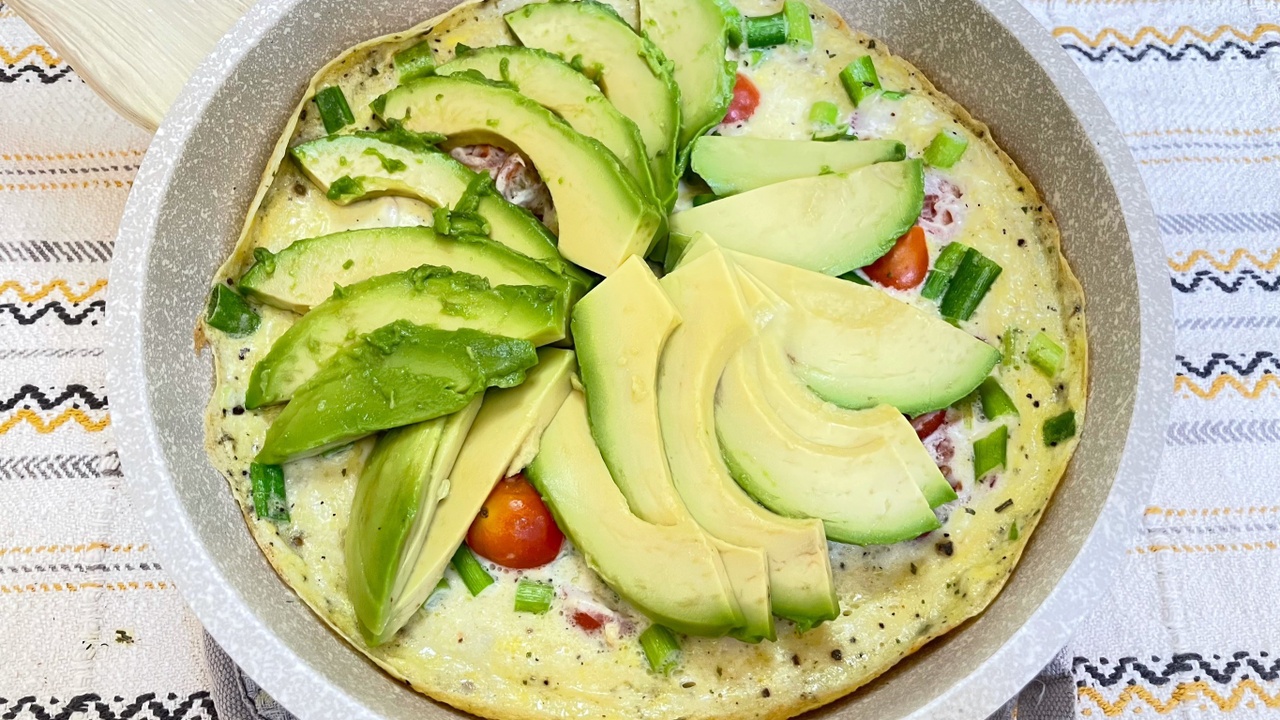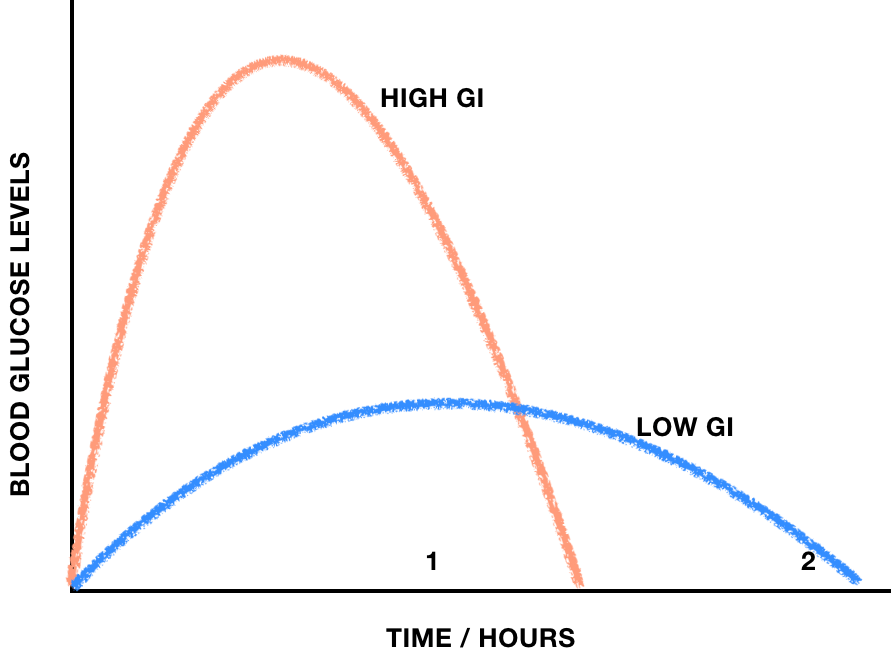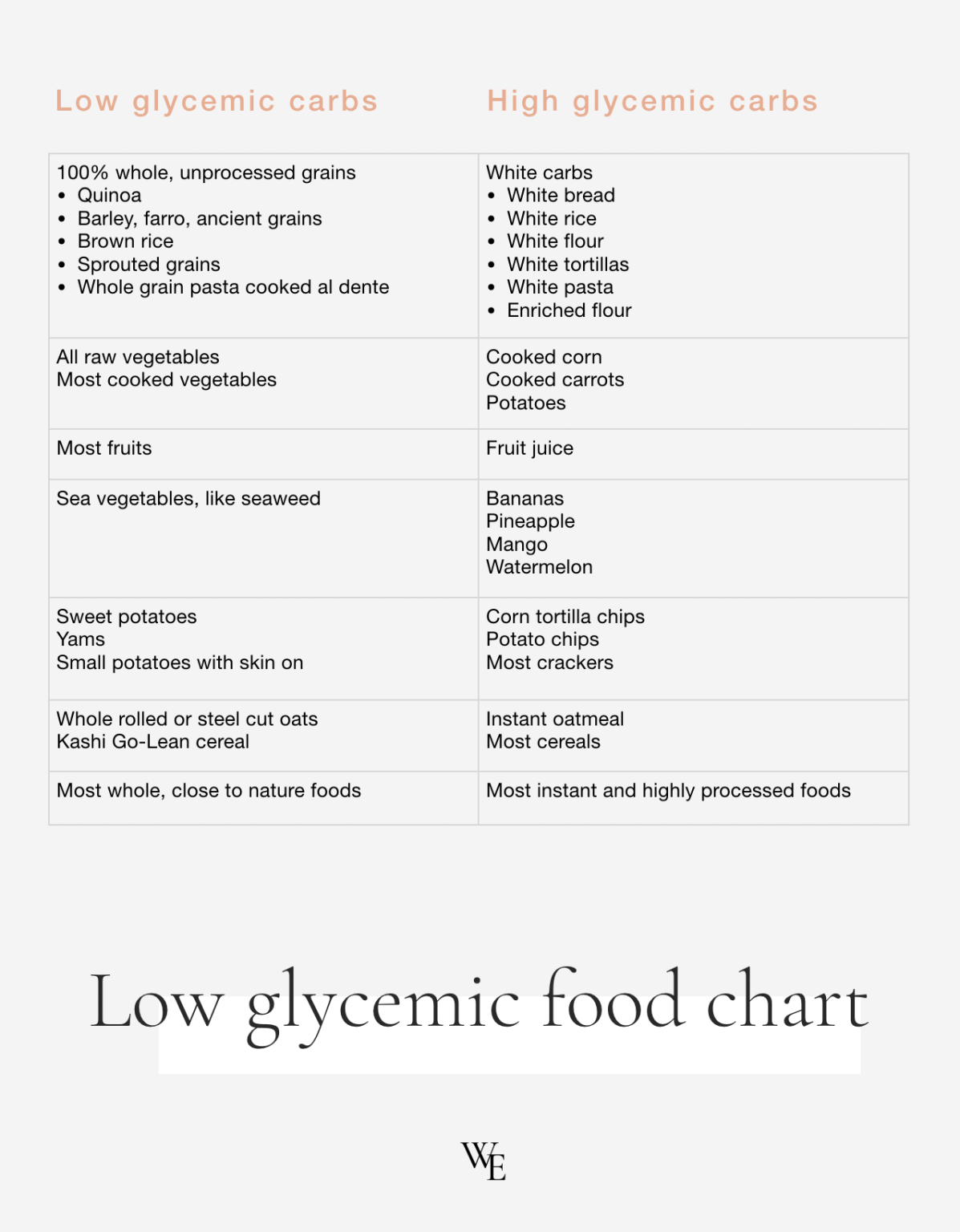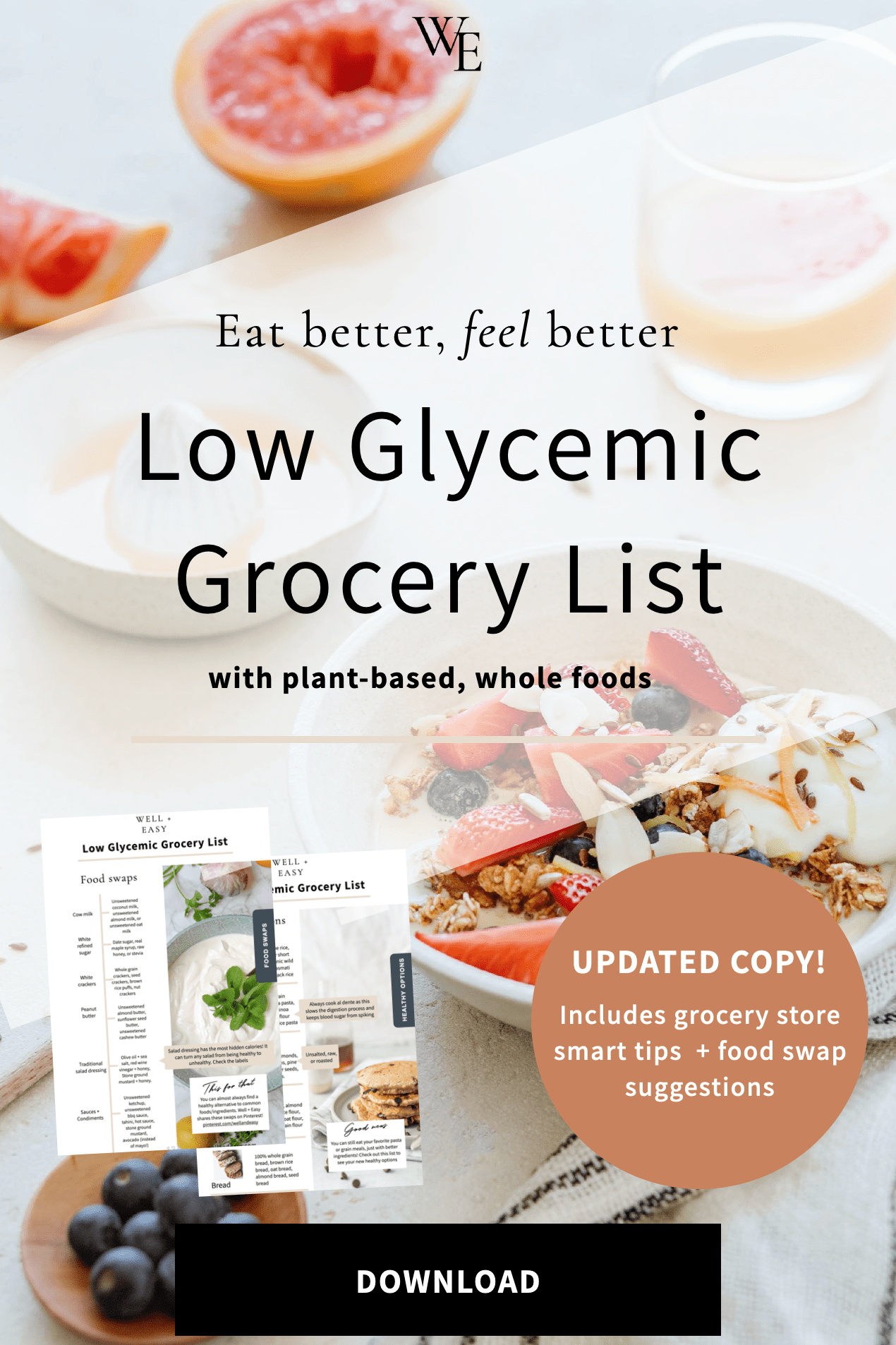The Low Glycemic eating diet plan

Balance your blood sugar and reset your hormones to permanently speed up your metabolism and manage weight naturally.
Low Glycemic eating is the best way I’ve found to lose and maintain a healthy weight, beat sugar cravings (and bingeing), and feel overall better in my body. Low GI foods help the body sustain energy throughout the day by keeping your blood sugar from spiking and dropping constantly. This is super important, and I'll explain why later.
What's included in this guide
- What is the glycemic index
- The glycemic index & weight loss connection
- Benefits of low GI eating
- 30 day eating plan
- Tips for supporting low GI transition, overall health and balanced weight
- Free low GI for weight loss starter kit (filled with lots of meal ideas)
Understanding the glycemic index
The Glycemic Index is the measurement of the rate at which any food (carbohydrate) raises your blood sugar levels. One thing to note about GI is that proteins and fats do not raise blood sugar. Foods like eggs or olive oil do not have an impact when it comes to low glycemic eating as they do not contain glucose.
Glycemic Index is measured as the following:
- 0-55 = low
- 56-69 = medium
- 70+ = high
A food that is high on the glycemic index will spike your blood sugar really fast and after about an hour, your blood sugar will dip really low.

The orange line shows the rapid spike and plunge in glucose levels, and the blue line represents the slow role up and down of glucose levels in low glycemic index foods.
The glycemic index and weight loss connection
When your blood sugar spikes every day over a long period time your body will begin to store that energy as fat instead of using it.
This storage usually starts to happen in your late 20’s and early 30’s where you’ll notice it gets more difficult to lose weight and keep it off without much effort.
What’s happening is that muscle cells start to shut off insulin receptors, because so much insulin has been pumped into them. So, the fat cells take on all of the glucose (aka energy) and stores it as more fat. If it’s not being burned off, it’s stored as fat.
Thankfully this can be helped with a low glycemic diet.
Are carbs off limits?
Carbs are not off limits. Healthy carbs are good for you, they give your body energy, and are an essential part to eating well and easy.
That being said, the types of carbs that you’re consuming absolutely matter. In the free meal plan below, you’ll be presented with all of the low glycemic carb options you can and should eat. Well + Easy is here to make it easy, and as less restricting as possible.
Essentially, the types of carbs you want are fiber, and plenty of it!
The benefits of a low glycemic diet
While a low glycemic diet may not sound that exciting, it’s one of the best diets out there, along side the Mediterranean diet and the Blue Zone diet—which are both naturally low glycemic diets.
- Sustainable weight management that can easily be maintained
- Once you learn how to eat and what to eat on the Low GI diet, you’ll know it for life
- Low glycemic eating has many options and doesn’t require counting calories
- You can lose inches naturally even if you’re not exercising
Why go low GI?
Your health is your wealth. Whether you’ve heard this saying before or it’s your first time hearing it, it’s true for many reasons. Good health means having more energy, better sleep, an improved immune system, natural and healthy weight, and even clearer skin. Good health on a low glycemic diet means feeling lighter in your body, eating naturally better whole foods, and opening up to a world of new options you can eat without feeling guilty.
My journey with low GI eating
First, when I discovered this way of eating it was a relief to know it's actually not restricting or expensive. Second, I had found a way of eating that made the most sense and explained my eating habits. I learned the reason I was craving salty foods, constantly going for something sweet around 10am each morning, and couldn’t get rid of my bloated stomach. This information also explained why it became harder and harder to lose weight and keep it off after I turned 30.
If you're struggling with this too it's not your fault. It's simple biology. As a nutrition expert and researcher, I studied blood sugar, metabolism, and hormones and discovered that all those healthy green juices I was drinking were actually impacting my blood sugar levels negatively—based on science. And now I understand that I can still have green drinks, but with add nutrients to ensure it's balanced. Sometimes it's just a matter of adding in some chia seeds or protein powder or 1/2 an avocado.
Know what foods are good to eat, and how to combine them, and you'll radically change your body and life. Stick with me and I'll show you how.
Will a low glycemic diet work for you
Your body is used to the rise and fall in glucose levels, it will take time to get those signals working again. It can take 6-8 weeks for your body to reset and it's helpful to remember that your current health state is a result of years of eating habits. There’s no quick fix to “undo” it all, however in 6-8 weeks you can get back on track.
Eventually low GI becomes a way of eating rather than another fad diet. You learn what to eat, how to eat, when to eat, and you lose and maintain your weight simply.
If weight loss becomes stagnant or plateaus, there's simple things you can do to kick start your metabolic rate and revive that fat burning like eating more or switching up your workout.
A 30 day low glycemic eating plan
If this eating plan is something you’d like to try I recommend sticking with it for 6-8 weeks. It’s a very flexible way of eating and doesn’t restrict you from eating foods you love. Most importantly, you don’t have to count calories or points and can still lose weight with very little exercise.
For the next 30 days, here’s the plan:
- Eat as low GI as possible with foods from the approved list below and the meal plan.
- Moderate exercise and/or mindful movement (sneaking in ways to workout)
Breakfast recipes
- Kale, Feta, and Egg Burrito
- Mashed Sweet Potato Breakfast Bowl
- Chickpea Omelette with Asparagus
- Cinnamon Pear Oatmeal Bowl
- Black Bean Egg White Omelette
Lunch + Dinner recipes
- Cucumber & Pepper Tabbouleh with Chicken
- Chicken & Cilantro Lime Quinoa Bowl
- Sushi Bowl
- Chicken, Kale, and Avocado Bowl
- Tuna, Spinach, and Feta Pita Wrap
- Chicken & Cream Cheese Wrap
- Cheese Burger Salad *my personal favorite!!
Snack recipes
Don't wait to start, download your FREE Low GI for Weight Loss starter kit!
Click here to download the 7 day Low GI Meal Plan & Kitchen Checklist
What is included in the starter kit?
The starter kit I've put together includes a 7-day sample meal plan, filled with simple recipes that you can start incorporating into your life. It makes the transition to this diet so much easier.
The kit also includes a grocery list for the meal plan so you know exactly what to get and how much. If you're making meals for your family, the recipes can be easily scaled to increase the amount and make more for everyone to enjoy.
Lastly, the kit includes my blood sugar bestie kitchen checklist. This checklist will walk you through the staples that should be in your kitchen. These staples are the foundation for making this new healthy lifestyle much smoother.
Do I need the starter kit?
While you don't need the starter kit, I put it together just to make things easier for you! I want to make sure you walk away from this article with everything you need to get started in the right direction.
Searching for information on the internet can be exhausting, believe me I've done it. And spending your Sunday nights trying to reset your diet for Monday is not fun. I want to provide the opportunity to give you peace of mind, but also ease so you're not spending hours in the kitchen.
Check out the starter kit so you at least have it saved to your computer or phone!
List of Low GI foods
The below tables will give you a good idea of where food falls on the Glycemic Index. This is only a small list, and remember by nature of the foods, all fats and proteins are low glycemic. Use this list to give you more ideas on what foods you can start adding into your diet, and begin making yummy meals that can help reset your blood sugar and metabolmism naturally.

Recommendations to support an easy low GI transition & balance weight
- The 7 day Low GI Meal Plan & Kitchen Checklist (free) to get you going in the right direction today.
- Don't skip meals, 5 meals a day is key to keep blood sugar stable
- Get in exercise throughout the day or once a day through mindful movement (like parking further from the grocery store to walk or taking stairs instead of elevators)
- Balance every meal with healthy fats, healthy proteins, and healthy carbs. The meal plan will give you good ideas of what this looks like.
A few last things, eat as close to nature as possible. When you feel like you've "fallen off the wagon", go easy on yourself and get back on. Lastly, changing your eating habits can be tough, so I recommend starting small and introducing one thing at a time. You can start by seeing the good low GI foods you have, and then see what things you can add in.
You will see changes soon, stick with it. Again, it will take at least six weeks to reset your body.




